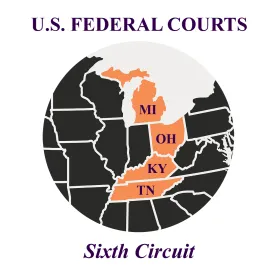Today, the Sixth Circuit will consider another governmental mandate–this one, a tax mandate–as it hears argument (by video) in a case that pits Ohio once more against the federal government. The case is Ohio v. Yellen, No. 21-3787. The panel consists of Judges Griffin, Donald, and Bush. Argument is expected to start around 9:30. You can find a link to a live audio stream of the argument here.
The origins of this case go back further than any of the vaccine-related mandates that have dominated headlines (including this Blog’s) for the past several weeks. On March 11, 2021, President Biden signed into law the American Rescue Plan Act (“ARPA”). Through ARPA, Congress committed to spending roughly $1.9 trillion to address the harms, including economic harms, that COVID-19 has caused.
As relevant here, ARPA appropriates around $195.3 billion in funding to assist the States’ economic recovery from the pandemic. At the time of ARPA’s enactment, Ohio stood to receive $5.4 billion of that money, representing roughly 7.5% of the State’s total spending. But the money came with strings attached. Besides limiting what a State could spend the funds on, ARPA also prohibited each State from “us[ing] the funds … to either directly or indirectly offset a reduction in the net tax revenue of such State” through, among other means, legislation or regulation. 42 U.S.C. 802(c)(2)(A). This is the so-called tax mandate at the heart of the case.
Ohio never made any secret about its intent to take the money. In Ohio’s view, Congress had made all of the States an offer they couldn’t refuse. But that didn’t stop Ohio from suing the Biden Administration (through the Treasury Secretary, among others) just six days after President Biden signed ARPA into law. By filing suit, Ohio hoped to take the money free and clear of the tax mandate.
Ohio filed suit in the Southern District of Ohio, arguing that the mandate was unconstitutional for two reasons. First, Ohio argued that the mandate violated the Spending Clause in that the mandate was both unconstitutionally coercive and unconstitutionally ambiguous. Second, Ohio argued that the tax mandate violated the Tenth Amendment by unconstitutionally commandeering state taxing authority. Ohio simultaneously filed a motion for a preliminary injunction that would prevent the Secretary from enforcing the tax mandate during the litigation’s pendency. In responding to that motion, the Secretary countered that Ohio lacked standing to press its claims because Ohio was in no danger of suffering an immediate recoupment. Indeed, Ohio had not even formally requested the funds as of the time it filed suit. The Secretary also disputed that the statute violated either the Spending Clause or the Tenth Amendment.
On May 12, 2021, after hearing argument on Ohio’s motion, Judge Douglas R. Cole issued an opinion and order that essentially agreed with Ohio on standing and the merits but nonetheless denied Ohio a preliminary injunction (more on that wrinkle in a bit). On standing, Judge Cole held that the Spending Clause entitled Ohio to clarity regarding the “terms of the deal” and that depriving Ohio of that “constitutionally-mandated clarity” was “a sufficient injury for Article III standing purposes.” The District Court also found that Ohio had shown a likelihood of success on the merits, at least with respect to Ohio’s ambiguity argument, concluding that the tax mandate’s statutory language “fell well short of the clarity threshold that Spending Clause jurisprudence imposes.” “Despite poring over [the] statutory language, the Court [could not] fathom what it would mean to ‘indirectly offset a reduction in the net tax revenue’ of a State, by a ‘change in law … that reduces any tax.'” According to the District Court, that statutory language left key questions unanswered, such as, what baseline would be used to calculate changes in net revenue? And how would various potential changes to a State’s taxes be scored?
The District Court nonetheless concluded it was unable to grant a preliminary injunction to Ohio because that “type of interim relief could not provide Ohio the clarity it sought in terms of deciding whether to accept the deal.” Moreover, “as a practical matter … it was unlikely (indeed virtually impossible) that the Secretary would seek recoupment” during the pendency of the litigation. But the District Court’s reasoning suggested that these issues would not pose obstacles to Ohio obtaining a permanent injunction against the mandate’s enforcement. And sure enough, after expediting briefing on the matter, the District Court granted Ohio a permanent injunction for largely the same reasons it earlier concluded that Ohio was likely to succeed on the merits. In this second order, however, the District Court more fully explained why certain guidance the Secretary had promulgated after Ohio filed suit could not save the tax mandate.
In their briefs before the Sixth Circuit, Ohio and the federal government make many of the same arguments they made below on standing and the merits. It remains to be seen whether the Sixth Circuit upholds the District Court’s injunction. But, as with the OSHA mandate, given the stakes involved, it seems likely that no matter what the Sixth Circuit decides, the Supreme Court will have the final word on this issue.




 />i
/>i

